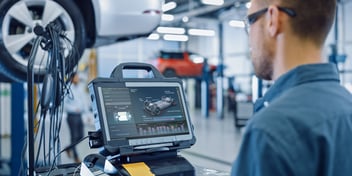

Do you have robust connectivity for your IoT fleet management?
Feeling overwhelmed with managing your fleet? This blog explains why using IoT for fleet management and monitoring is the perfect solution for your challenges.
Fleet Management Basics:
Fleet management is like being the captain of a group of vehicles, making sure they work well and don't cost too much. It involves picking the right vehicles, keeping them in good shape, and using fuel wisely. Things like planning routes, training drivers, and using technology to keep track of everything are important. The main goal is to run the fleet smoothly, save money, and be kind to the environment. Technologies like GPS and data analytics make managing fleets easier.
In the fast-changing world of transportation, good fleet management is crucial for success. Fleet managers deal with different challenges, like finding the best routes and keeping vehicles and cargo safe. This is where IoT, or the Internet of Things, comes in handy. It brings in smart solutions that change how fleets operate.
Fleet Management Challenges:
- Data Overload: Handling lots of information, from how much fuel is used to how often vehicles need maintenance in fleet monitoring.
- Security Risks: Worrying about problems in the systems that collect data in fleet management.
- Power Supply Issues: Dealing with maintaining devices that each need their power in fleet monitoring.
- Limited Visibility: Not having real-time information makes it hard to make quick decisions in fleet management.
- Operational Inefficiencies: Struggling to predict when vehicles need maintenance or the best routes in fleet monitoring.
What is IoT Fleet Management? What Are the Use Cases?
IoT-based Fleet Management uses IoT to tackle these challenges. By integrating IoT-enabled devices in vehicles, real-time connectivity between vehicles, the cloud, and fleet managers is achieved.
Use Cases:
- Fleet Predictive Maintenance: Fixing issues before they become big problems in fleet monitoring.
- Asset and Cargo Management: Making sure resources are used well for good fleet performance in fleet management.
- Fuel Management: Keeping an eye on fuel use to save costs and be eco-friendly in fleet monitoring.
- Route Planning: Making routes more efficient to save fuel and time in fleet management.
- Vehicle Monitoring for Security: Preventing theft and keeping cargo safe in fleet monitoring.
- Driver and Passenger Safety: Putting measures in place for safer operations in fleet management.
- Passenger Counting and Ticketing: Making public transit operations smoother in fleet monitoring.
- Work Zone Analytics: Using data for better efficiency in work zones in fleet management.
- Road Asset Management: Improving how road assets are managed for smoother operations in fleet monitoring.
Benefits of IoT Fleet Management:
Improved Safety:
- Real-time Computer Vision: Enhances safety through driver monitoring, blind spot detection, and fatigue warnings.
- Accident Reduction: Up to 40% reduction in accidents.*
- Theft Reduction: Up to 25% decrease in theft incidents.*
Cost Savings and Efficiency:
- Predictive Maintenance: Up to USD 26M savings for a 1,000-vehicle fleet.
- Route Optimisation: Reduction in fuel consumption and idle time by 25%.*
- Insurance Claim Reduction: Up to 60% reduction in insurance claims.*
Expanded Connectivity:
- Onboard IoT-Enabled Devices: Enable powerful, fast, and reliable connectivity.
- Real-time Data Analysis: Facilitates near-real-time monitoring and decision-making.
Increased Sustainability:
- Reusable In-vehicle Devices: Outlive specific vehicles, increasing return on investment.
- Fuel Consumption Monitoring: Manages fuel usage, reducing the carbon footprint.
Why Robust Connectivity is Critical in IoT Fleet Management:
In the intricate web of IoT-enabled fleet management, robust connectivity emerges as a linchpin. The efficacy of real-time data exchange between vehicles, cloud servers, and fleet managers relies heavily on the strength and reliability of the connectivity infrastructure. Key considerations include:
- Real-time Monitoring: Robust connectivity facilitates instantaneous data transmission, allowing fleet managers to monitor vehicle conditions, driver behavior, and cargo status in real-time.
- Data Analysis: The seamless flow of data enables near-real-time analytics, empowering fleet managers with timely insights into operational trends, potential issues, and opportunities for improvement.
- Remote Management: A strong connectivity framework enables remote management capabilities, allowing fleet managers to intervene, guide, or make decisions promptly, irrespective of the vehicle's location.
- Enhanced Decision-making: Access to continuous, high-quality data supports informed decision-making, enhancing the overall efficiency and safety of fleet operations.
Do You Have the Connectivity You Need for Your IoT Fleet Management?
In the world of IoT-based fleet management, picking the right partner for reliable connectivity is like picking the heart that keeps everything running smoothly. As fleets go all around the world, having a partner that offers global connections is a must. Learn from Velos IoT's knowledge about IoT connectivity for fleets:
- Global Coverage for Uninterrupted Services in Fleet Management: Wherever your fleet goes, having good connectivity is necessary. Look for a partner that can make sure your IoT devices can talk to each other reliably, whether you're in a busy city or a faraway place.
- Network Selection Control in Fleet Monitoring: Being able to pick the right network is important. Your IoT partner should let you choose the network based on what you need. Whether you like a specific network in one place or need to switch, having control helps in fleet management.
- Simplified Connectivity Management for Scalability in Fleet Management: As your fleet grows, managing connections should be easy. Look for a partner that makes IoT connectivity simple. This includes features like quick reports, controlling costs, and watching devices. A streamlined Connectivity Management Platform should cover everything from starting up to keeping things going, especially as your fleet gets bigger.
Choosing the right partner is more than just getting a good connection; it's about making sure your fleet is ready for the future. By looking for global coverage, control over networks, and simple connectivity management, you set your fleet up for success in the ever-changing world of smart transportation.
Ready to Transform Your Fleet Operations? 
Download the E-Book: Do you have the global coverage you need for your IoT projects?
Get deeper insights into making sure your fleet has the global coverage it needs. Download the comprehensive e-book from Velos IoT for valuable tips and strategies on navigating the IoT landscape and optimising
connectivity for your fleet.
* Andrea Thomas, Miao Wei, and Ryan Matsumura, “Empowering the Mobility Fleet of Tomorrow,” Intel, accessed September 2022, intel.com/content/www/us/en/transportation/overview.html.
Speak to a Velos IoT expert
Related articles


Real Time Managed IoT Connectivity Platform
Take full control of IoT devices with a managed IoT connectivity platform that empowers you with...

What Can You Expect From An IoT Connectivity Management Platform?
There are many elements in a successful IoT deployment. Apart from hardware, connectivity, and...

